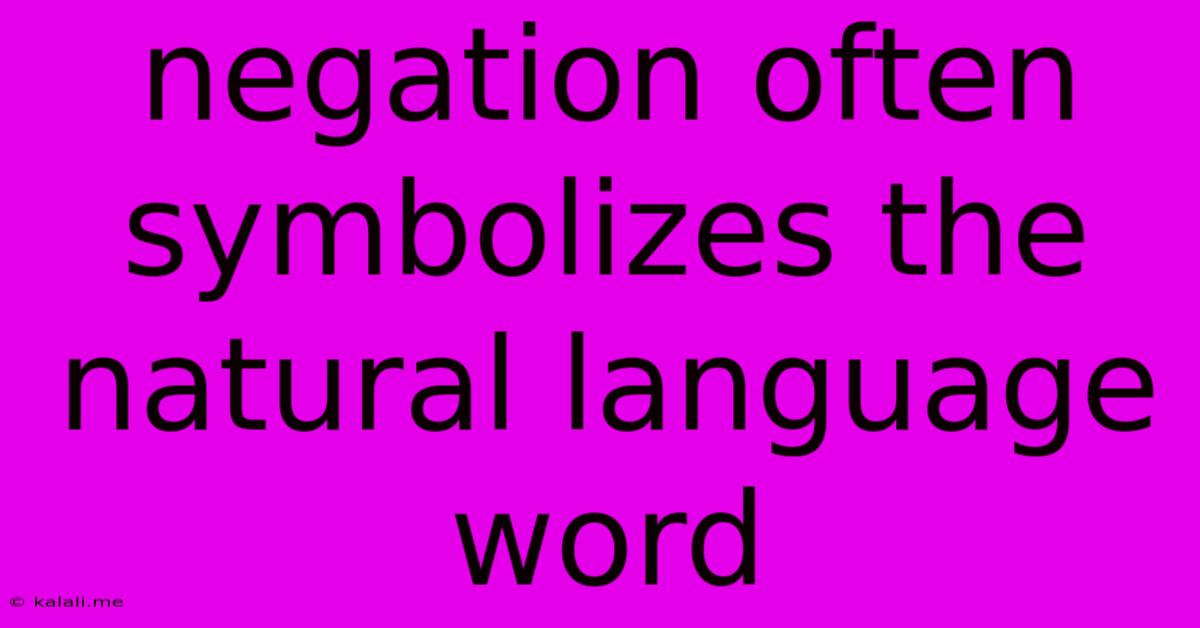Negation Often Symbolizes The Natural Language Word
Kalali
Jun 08, 2025 · 3 min read

Table of Contents
Negation: The Unsung Hero of Natural Language Processing
Negation, often represented by words like "not," "no," "never," and their various forms, is far more than a simple grammatical element. It's a powerful linguistic tool that dramatically alters the meaning of sentences and plays a crucial role in natural language understanding. This article delves into the complexities of negation in natural language processing (NLP), exploring its various forms, challenges, and importance in achieving accurate semantic analysis. Understanding negation is key to building robust and intelligent NLP systems.
Negation isn't just about flipping the truth value of a statement; it significantly impacts the interpretation of the entire sentence. Consider the difference between "The cat is on the mat" and "The cat is not on the mat." The simple addition of "not" completely changes the meaning. This seemingly simple addition presents complex challenges for NLP models.
Types of Negation and Their Nuances
Negation isn't monolithic. It manifests in several ways, each requiring careful consideration in NLP:
-
Explicit Negation: This is the most straightforward type, using explicit negation words like "not," "no," "never," etc. Identifying these words is relatively simple, but understanding their scope is crucial. For example, in "I did not go to the park because I was tired," the negation applies only to the action of going to the park, not to the reason for staying home.
-
Implicit Negation: This is far more challenging. Implicit negation relies on context and inference. Phrases like "He failed to arrive on time" or "The absence of rain" express negation without using explicit negation words. Detecting implicit negation requires sophisticated NLP techniques, often leveraging semantic analysis and contextual understanding.
-
Scope of Negation: Determining what part of the sentence a negation applies to is crucial. A single negation word can affect multiple clauses, phrases, or even an entire sentence. Ambiguity often arises, requiring advanced parsing and semantic understanding to resolve. Consider, for instance, "I didn't see the dog or the cat." Does the negation apply to seeing both animals or only the dog?
-
Nuanced Negation: Language rarely uses pure, simple negation. Words like "hardly," "scarcely," and "barely" express degrees of negation, requiring a more granular understanding than simple binary negation (true/false).
Challenges in NLP for Negation Handling
Processing negation effectively is a significant challenge in NLP due to several factors:
-
Ambiguity: As mentioned earlier, the scope of negation is often ambiguous, leading to incorrect interpretations.
-
Context Dependence: The interpretation of negation strongly depends on the surrounding words and the overall context of the sentence.
-
Implicit Negation Detection: Identifying implicit negation requires advanced semantic analysis and the ability to infer meaning from context.
-
Handling Multiple Negations: Sentences with multiple negations ("I didn't not go") require special handling to correctly determine the overall polarity.
The Importance of Accurate Negation Handling
Accurate negation handling is crucial for various NLP applications:
-
Sentiment Analysis: Misinterpreting negation can lead to entirely incorrect sentiment scores. For example, misinterpreting "The movie wasn't bad" as negative would be a significant error.
-
Question Answering: Incorrectly interpreting negation in questions can lead to inaccurate answers.
-
Machine Translation: Accurate translation requires understanding and correctly representing negation in the target language.
-
Information Retrieval: Searching for information involving negation requires sophisticated search algorithms that can handle negated queries effectively.
Conclusion
Negation is a fundamental aspect of human language that poses significant challenges in NLP. Developing robust methods to accurately identify, interpret, and process negation is crucial for building advanced NLP systems capable of truly understanding the nuances of human communication. Further research in this area, focusing on improving contextual understanding and semantic analysis, is crucial for advancing the field. Future breakthroughs in understanding nuanced negation and implicit forms will unlock even more sophisticated NLP applications.
Latest Posts
Latest Posts
-
Can A Sniper Round Penetrate A Tank
Jun 08, 2025
-
Attributeerror Module Serial Has No Attribute Serial
Jun 08, 2025
-
Do You Need To Refrigerate Vinegar
Jun 08, 2025
-
Hope This Email Find You Fine
Jun 08, 2025
-
Car Only Starts When Jumped But Battery Is Good
Jun 08, 2025
Related Post
Thank you for visiting our website which covers about Negation Often Symbolizes The Natural Language Word . We hope the information provided has been useful to you. Feel free to contact us if you have any questions or need further assistance. See you next time and don't miss to bookmark.